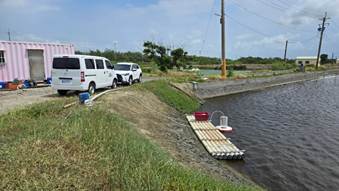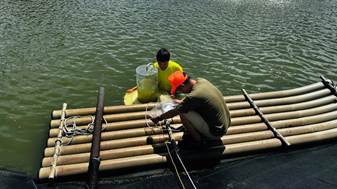13.4.1
- Achievement of Carbon Neutral University
NTOU's carbon emissions can be divided into two primary Scope: Scope 1, direct emissions, such as the amount of fuel used for buses and heating boilers; and Scope 2, indirect emissions, such as the amount of electricity used on campus.
NTOU has set up a carbon reduction plan to achieve the goal of a carbon-neutral university. The methods of reduction include: reducing carbon dioxide production, for example, 1) cooperating with the government's Four Saves Program (saving electricity, water, oil, and paper), and 2) improving energy efficiency (using energy-saving labeled products, energy-efficient air conditioners, energy-saving light bulbs, and applying for green building and intelligent building labels). In addition, taking advantage of NTOU's geographical location near the mountains and the sea, we have installed solar power equipment in the parking lot and started the carbon reduction projects of campus forestation (large trees) and sea forestation (large seaweed). According to the calculation, NTOU has made a commitment of carbon neutrality by 2049. On the other hand, NTOU's "NTU Rainwater Park" and "Longgang Ecological Park" have been certified as environmental education facilities by the Environmental Protection Agency. These are promoting ecological education and integrating environmental education on campus into community life to achieve sustainable development and help improve the deteriorating environment. In the future, we plan to build a beach on Beining Road to turn the university into a forest and seascape campus.
Sustainable Impact: NTOU is actively pursuing carbon neutrality by implementing strategies to reduce both direct and indirect emissions. The university focuses on energy efficiency improvements, renewable energy use (solar power), and campus reforestation. These efforts align with Taiwan’s commitment to carbon neutrality by 2049, while promoting environmental education through certified facilities and community outreach.

永續影響力: 致力於實現碳中和,透過節能減碳、太陽能設置與綠化計畫,達成2049年碳中和目標。並結合環境教育與社區生活,促進永續發展與生態保護。
Evidence: https://mprp.ntou.edu.tw/p/16-1017-75433.php?Lang=zh-tw
- Investigation on aquaculture carbon sink and establishment of measurement methodology 養殖漁業碳匯調查及建立量測方法學研究
Due to the absence of a matching Monitoring, Reporting, and Verification (MRV) mechanism in our country, the national greenhouse gas emissions inventory has yet to establish wetland-related carbon sink data. In order to understand the overall carbon sink variations and potential reductions in emissions in our country, as well as to adhere to the three core principles (measurable, verifiable, and reportable) and five key characteristics (additivity, conservatism, permanence, avoidance of harm, and avoidance of double counting) required for future voluntary reduction projects, this project will focus on carbon sinks in aquaculture, including the milkfish and sea bass farming industries. We will measure the greenhouse gas emissions and carbon sinks in water bodies and sediments, and analyze their local coefficients. The goal is to accurately estimate the carbon sink or carbon source capabilities of wetlands in line with the international trend towards net-zero emissions and to achieve the domestic net-zero emissions policy objectives.
Sustainable Impact: This project addresses the current gap in Taiwan’s national greenhouse gas inventory, which lacks wetland carbon sequestration data. It focuses on measuring greenhouse gas emissions and carbon storage in milkfish and seabass aquaculture systems, including both water and sediment compartments, to establish localized carbon coefficients. The study supports the development of Taiwan’s Monitoring, Reporting, and Verification (MRV) framework and aligns with the three key MRV principles—measurability, verifiability, and reportability—as well as the five essential attributes of carbon management: additionality, conservativeness, permanence, avoidance of leakage, and prevention of double counting.
The outcomes will enhance national understanding of wetland carbon fluxes, inform voluntary mitigation programs, and contribute to net-zero strategies under SDG 13.3–13.4. Simultaneously, the research advances sustainable aquaculture and coastal wetland carbon management, aligning with SDG 14.2–14.3. By quantifying blue carbon potential and integrating it into national climate policy, this project builds a scientific foundation for low-carbon aquaculture and climate-resilient marine ecosystems in Taiwan.
因我國尚未建立相符之監測、報告與驗證機制(MRV),國家溫室氣體排放清冊尚未建立濕地相關碳匯量數據,為了解我國整體之碳匯變動量及可減少之排放量,以及未來自願減量專案中所需之三大原則(可量測、可驗證、可報告)和五大特性(外加性、保守性、永久性、避免產生危害及避免重複計算),本案將針對養殖漁業碳匯,包含虱目魚及鱸魚養殖產業,進行水體及底土之溫室氣體與碳匯量測,並分析其本土係數,期望可精確的推估濕地的碳匯或碳源能力,以符合國際淨零排放趨勢及達到國內淨零排放政策目標。
永續影響力: 本計畫針對我國尚未納入國家溫室氣體清冊之「濕地碳匯」議題,進行養殖漁業(虱目魚與鱸魚產業)水體與底土之溫室氣體排放與碳匯量測,建立本土化碳吸存係數,補足我國MRV(監測、報告、驗證)機制缺口。研究結果將有助於掌握濕地碳源與碳匯變動,為自願減量專案奠定基礎,符合「可量測、可驗證、可報告」三原則及五項碳管理特性(外加性、保守性、永久性、避免危害、避免重複計算)。 此研究不僅支援國家淨零排放政策與氣候治理(SDG13.3.1–13.4.1),亦促進海岸與養殖濕地的生態碳匯功能理解(SDG14.2.1–14.3.3),為台灣藍碳管理與低碳漁業發展提供重要實證依據。


Evidence: